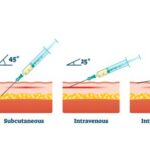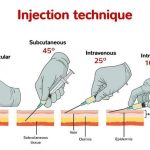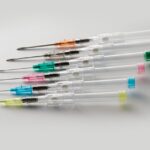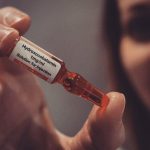Why Are Subcutaneous Injections Given At A 45-Degree Angle?

A subcutaneous injection is a method of administering medication. Subcutaneous means under the skin. In this type of injection, a short needle is used to inject a drug into the tissue layer between the skin and the muscle. Medication given this way is usually absorbed more slowly than if injected into a vein, sometimes over a period of 24 hours.
This type of injection is used when other methods of administration might be less effective. For example, some medications can’t be given by mouth because acid and enzymes in the stomach would destroy them.
Other methods, like intravenous injection, can be difficult and costly. For small amounts of delicate drugs, a subcutaneous injection can be a useful, safe, and convenient method of getting a medication into your body.
Medications given using a subcutaneous injection
Medications administered by subcutaneous injection include drugs that can be given in small volumes (usually less than 1 mL but up to 2 mL is safe). Insulin and some hormones are commonly administered as subcutaneous injections.
Other drugs that need to be given very quickly can also be administered via subcutaneous injection. Epinephrine comes in an automated injector form, called an EpiPen, that’s used to quickly treat severe allergic reactions. While it’s intended to be given intramuscularly, epinephrine will also work if given subcutaneously.
Some pain medications like morphine and hydromorphone (Dilaudid) can be given this way as well. Drugs that prevent nausea and vomiting like metoclopramide (Reglan) or dexamethasone (DexPak) can also be given via subcutaneous injection.
Some vaccines and allergy shots are administered as a subcutaneous injection. Many other vaccines are administered as an intramuscular injection — into muscle tissue rather than under the skin.
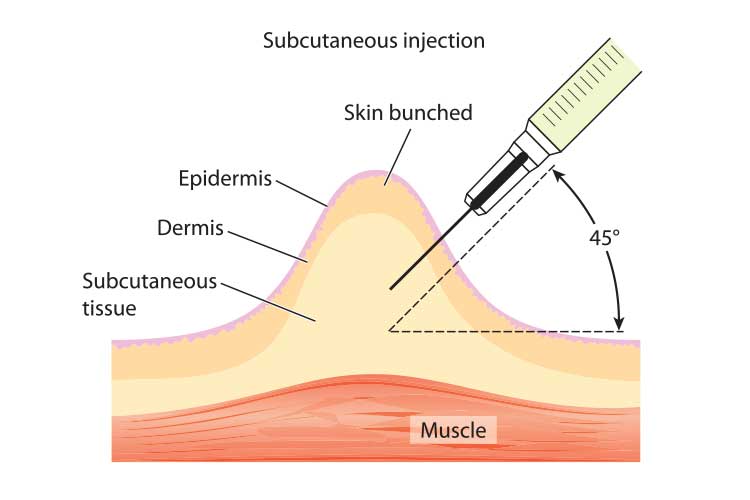
Why Are Subcutaneous Injections Given At A 45-Degree Angle?
A subcutaneous injection is usually given at a 45- to 90-degree angle. For patients with little subcutaneous tissue, it is best to insert the needle at a 45-degree angle. Subcutaneous injections are based on the amount of subcutaneous tissue present. Shorter needles are given at a 90-degree angle and longer needles at a 45-degree angle.
Subcutaneous injections are a relatively convenient way to deliver medication that would otherwise be absorbed too slowly or made ineffective if given by alternative routes. Subcutaneous injections may be given either by manual syringe, pen injectors, syringe drivers, infusion or jet infusion sets.
Subcutaneous injections do not need to be aspirated as the likelihood of injecting into a blood vessel is small. Usually, no more than 1 ml of medication is given subcutaneously, as larger amounts may cause discomfort to the patient and may not be absorbed appropriately.
There are varying opinions on whether to pinch the skin during administration. Pinching is advised for thinner patients in order to lift the adipose tissue up and away from the underlying muscle and tissue. If pinching is used, release the pinch when the needle is inserted to avoid injecting into compressed tissue. Note, too, that elevating or pinching the skin has been found to increase the risk of injury, as the needle may pierce the opposite side of the skin fold and enter the skin of the healthcare worker.
Where is the best location to administer a subcutaneous injection?
The abdomen is the best location for a subcutaneous injection if a patient has little peripheral SC tissue. If the patient is obese, use a needle that is long enough to insert through the tissue at the base of the skin fold.
However, injecting through clothing is discouraged as the person is unable to inspect the site, or properly use a lifted skin fold if required. Furthermore, the advent of shorter needles means that the injection may not penetrate the skin sufficiently for the correct administration of medicine into the subcutaneous space.
How to do a subcutaneous injection
To give a subcutaneous injection, people should follow these steps:
- Choose a fatty area of the body, such as the abdomen, back of the arm, or thigh: If you are giving several injections or have to do daily injections, rotate the sites to allow each area to heal between injections
- Wash hands before cleaning the area with an alcohol pad: Wait for the area to completely dry before the next step.
- Take the cap off the needle: Draw medication into the syringe, according to the directions on the vial. This usually means turning the vial upside down then pulling the plunger back to suck in the medication. Tap the syringe to get rid of air bubbles.
- Pinch a fold of skin: Pinch the fatty area about 2-inches thick in between the thumb and a finger.
- While holding the needle like a dart, slide it into the skin at an angle of 90 degrees: Needles used for subcutaneous injection are usually short and small and should go all the way into the skin.
- Push the plunger all the way down quickly: Do not push forcefully.
- Cover the needle: Dispose of the needle in a needle-safe container.
The best location for a subcutaneous injection depends on a person’s pain sensitivity and where they have some subcutaneous fat.

